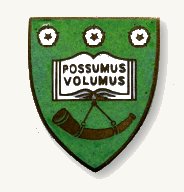1958 Trip
May 1958 trip to Germany and Switzerland
 Two coaches down the Great North Road to London where a meal and a quick tour of the City followed. The cross Channel ferry from Dover to Dunkirk followed by a journey across the Belgian countryside. A quick glimpse of the Exhibition was seen in Brussels before a one hour stop in Louvain. “Here for the first time we we were able to air our French and most of us acheted some cartes postales to envoyer chez nous.”
Two coaches down the Great North Road to London where a meal and a quick tour of the City followed. The cross Channel ferry from Dover to Dunkirk followed by a journey across the Belgian countryside. A quick glimpse of the Exhibition was seen in Brussels before a one hour stop in Louvain. “Here for the first time we we were able to air our French and most of us acheted some cartes postales to envoyer chez nous.”
Crossing into Germany at Aachen the trip had its first experience of autobahn travel. “Mr Reynolds was much alarmed, mistrusting fast travel as much as he mistrusts fast bowling.” Cologne saw a cup of tea and a tour round the wonderful cathedral, miraculously unharmed in spite of the heavy war-time bombing. The coaches followed the Rhine Valley, through Bonn, to the resort of Koblenz for a meal and an overnight stay.
The following day the coaches continued on their way empty while the school party travelled by steamer up the Rhine to Rudesheim passing romantic-looking castles and the famous Lorelei Rock. Rudesheim had some picturesque corners, particularly a street called “the Throstle’s Nest”. The coaches met the party and they continued for a few more hours to Neckargemund, five miles east of Heidelberg. Here the party was divided between two hotels, the Hotel zum Goldenen Ochsen and the Kredell.
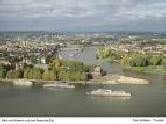

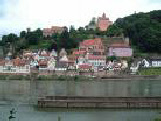

“Heidelberg is a lovely city, with a graceful and historic red stone bridge spanning a wide river. The old city, a picturesque huddle of buildings mostly of the same warm, mellow stone, climbs up one side of the steep valley towards the famous castle, which dominates the scene. We climbed the hill one afternoon - by funicular - and also spent some time in the castle.”

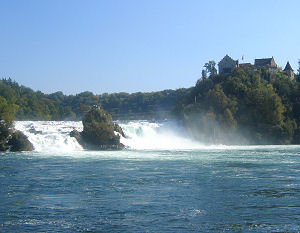 The days at Heidelberg passed quickly and the party once more embarked on a coach journey. This was a marvellous drive, first to Baden-Baden, into the heart of the Black Forest.. This is an area of steep, wooded hills, with, every so often, wonderful panoramic views. Towards the end of this journey they saw the source of the Danube at Donaueschingen, which proved a little disappointing. The Swiss border was soon reached and the party paused to look at the very spectacular Rhinefalls.
The days at Heidelberg passed quickly and the party once more embarked on a coach journey. This was a marvellous drive, first to Baden-Baden, into the heart of the Black Forest.. This is an area of steep, wooded hills, with, every so often, wonderful panoramic views. Towards the end of this journey they saw the source of the Danube at Donaueschingen, which proved a little disappointing. The Swiss border was soon reached and the party paused to look at the very spectacular Rhinefalls.
The party reached its final destination at the Gasthaus Loewen at Ebikon, a small village two miles out of Lucerne. Lucerne is a fine city with many points of interest - the lake overlooked by snow-clad peaks, dominated by Mount Pilatus. The party had a boat trip on the lake memorable by the waves whipped up by a “fohn” wind. ‘Mr Reynolds stood resolutely in the bows of the small boat, looking like Lord Nelson. We thought he was setting a noble example: he confided afterwards that he was merely standing close to Lawson, who has a medal for life-saving!’
Another excursion was to Altdorf, well known for its connection with William Tell whose statue adorns the market-place. There was also a full-day trip to Interlaken and beyond; over the Brunner Pass, through Brienz and Interlaken to Lauterbrunnen. Here is a narrow U-shaped valley flanked by high vertical cliffs down which pours beautiful waterfalls. Other sights included the Trummelbach Falls and Grundelwald. The last major trip was up Mount Pilatus by rack railway but this proved very crowded and the mountain was quickly enveloped in mist and cloud.

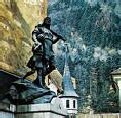

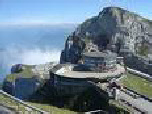
 ‘It was intended that the return journey should have taken us into France, but mistrustful of the political situation there (General de Gaulle was embarking on his “take-over bid) we deemed it wiser to stay on the German side of the frontier. We had arranged to feed at Lille, however, and preferring to risk being drafted into the Foreign Legion rather than throw away good Yorkshire brass, we crept cautiously over the border, ate, and crept out again before continuing to Dunkirk and the boat.’
‘It was intended that the return journey should have taken us into France, but mistrustful of the political situation there (General de Gaulle was embarking on his “take-over bid) we deemed it wiser to stay on the German side of the frontier. We had arranged to feed at Lille, however, and preferring to risk being drafted into the Foreign Legion rather than throw away good Yorkshire brass, we crept cautiously over the border, ate, and crept out again before continuing to Dunkirk and the boat.’
